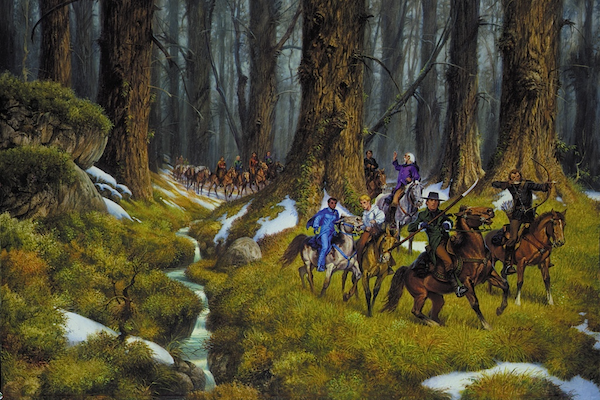Greetings, Professors! Shall we Redux a Wheel of Time Reread? Excellent!
Today’s Redux post will cover Chapter 28 of The Shadow Rising, originally reread in this post.
All original posts are listed in The Wheel of Time Reread Index here, and all Redux posts will also be archived there as well. (The Wheel of Time Master Index, as always, is here, which has links to news, reviews, interviews, and all manner of information about the Wheel of Time in general on Tor.com.)
The Wheel of Time Reread is also available as an e-book series! Yay!
All Reread Redux posts will contain spoilers for the entire Wheel of Time series, so if you haven’t read, read at your own risk.
And now, the post!
Before we begin, a reminder that the format of the Reread Redux has changed: from now on I am only going to be commenting on chapters in which my reaction has changed significantly from before, based on the knowledge I had at the time.
Though again I am picking up from where the last post left off, so again, doesn’t apply. It will next time, though.
But in the meantime, onward!
Chapter 28: To the Tower of Ghenjei
 Redux Commentary
Redux Commentary
Then something glittered ahead, sparkling in the sun, a tower of metal. His quarry sped straight for it, and vanished. Two leaps brought Perrin there as well.
Two hundred feet the tower rose, and forty thick, gleaming like burnished steel. It might as well have been a solid column of metal. Perrin walked around it twice without seeing any opening, not so much as a crack, not even a mark on that smooth, sheer wall. The smell hung here, though, that cold, inhuman stink. The trail ended here. The man—if man he was—had gone inside somehow. He only had to find the way to follow.
Stop! It was a raw flow of emotion that Perrin’s mind put a word to. Stop!
[…] You chase Slayer, Young Bull. He is here in the flesh, and he can kill.
Ah, the ever-mysterious Luc-Isam Collective, aka Slayer. Got all the way to the end of the series without ever completely learning his story, as it turned out. But the end of the series did sort of indirectly confirm my theory in the original commentary, which was that Slayer had no connection to the Finn, and did not in fact go inside the Tower of Ghenjei in this chapter, as Perrin thought, but instead merely led Perrin there as a hopefully deadly distraction. It’ll never be a hundred percent confirmed for sure, of course, because as I said the series as a whole never deigned to fully explicate to us all the ins and outs of Slayer’s personal history, but the lack of any further mention of a connection between the two (that I can recall, anyway) does seem to generally discredit the possibility.
Ergo, maybe Slayer and the Finn were total bros off-screen, but I tend to doubt it. I’m pretty sure Slayer leading Perrin to the Tower of Ghenjei was on par with leading him to a convenient pit trap that someone else built, just on the off-chance that Perrin would be stupid enough to fall into it.
Which, it must be said, he almost was. Although given Mat’s Moiraine-rescuing adventures in TOM, I’m not actually sure whether it would even be possible to get into the Tower without a handy ashanderei to do it with. Granted, Birgitte seems to think there is a way, and later tells about how one of her incarnations died inside, but as far as I recall she never got more specific on how exactly that version of her got in. So, in conclusion, dunno. Maybe it’s dangerous just to even be in the general vicinity of the thing.
I joked in the original post that Tel’aran’rhiod might as well be Old Tongue for “Infodump”, especially in the earlier books, and that is… still true. Heh. But, it was concurrently an excuse to introduce all kinds of wonderful fun mythological/historical references to the narrative, so that’s all right. And this chapter contains what is still one of my favorite references: the source of the name for the Tower of Ghenjei. Which is The Tale of Genji, generally considered to be the earliest work that qualifies as a novel, and which was written over a thousand years ago by a Japanese noblewoman known as Murasaki Shikibu. And in a spectacular example of the Baader-Meinhof phenomenon, a friend of mine just linked me to Anita Sarkeesian’s lovely tribute to her and her amazing achievement. The video’s less than four minutes long and well worth watching.
Aside from that, Birgitte also provides us with even more references:
“The tower? It is a doorway, archer, to the realms of the Aelfinn and the Eelfinn.” She said the names as if he should recognize them. When he looked at her blankly, she said, “Did you ever play the game called Snakes and Foxes?”
“All children do. At least, they do in the Two Rivers. But they give it up when they get old enough to realize there’s no way to win.”
“Except to break the rules,” she said. “ ‘Courage to strengthen, fire to blind, music to daze, iron to bind.’ ”
“That’s a line from the game. I don’t understand. What does it have to do with this tower?”
“Those are the ways to win against the snakes and the foxes. The game is a remembrance of old dealings. It does not matter so long as you stay away from the Aelfinn and the Eelfinn. They are not evil the way the Shadow is evil, yet they are so different from humankind they might as well be. They are not to be trusted, archer.”
Oh, so much yummy reference, it does my heart good. The ‘Finn, of course, are a play on the Faeries/Fae/Sidhe of Celtic mythology, which even the most casual fantasy reader has undoubtedly run into in any number of incarnations. The Aes Sedai are a more direct riff on the name, but the Aelfinn and Eelfinn are definitely the more similar in character to the Celts’ conception of the fae—most obviously, of course, in their aversion to iron, their susceptibility to music, and their general alien tricksiness. The Sidhe were even divided into two factions or Courts, the Seelie and Unseelie, and lived in what the Celts totally would have called an alternate dimension if they’d had the vocabulary for it, which could only be accessed by certain significant (and tricksy) ingress points.
As for the game of Snakes and Foxes, I probably do talk about it later, as I say in the original post, but even though I’m absolutely not going to track it down right now, I’ll bet you I said something about Chutes and Ladders, because that’s definitely what the game instantly made me think of. Except you can actually win at Chutes and Ladders, of course. Although as someone who can attest to this, thanks to certain young nephews who shall remain nameless, it can take unbelievably frickin’ long to finish, it can be won, so the analogy isn’t perfect. So maybe it’s more like Chutes and Ladders combined with Tic-Tac-Toe, or some other similarly unwinnable game that teaches you the futility of global thermonuclear war is basically designed to torture parents and/or child-adjacent adults. Yaaaaay.
Fun fact That I Did Not Know (Or Possibly Just Forgot) Until I Googled It Just Now: The game Chutes and Ladders, as commercialized by Milton Bradley in the States, is actually based on an ancient Indian board game called Snakes and Ladders, which means my association of the American game with Jordan’s Snakes and Foxes was absolutely not an accident. Though Jordan’s version seems to throw out the inherent morality aspect of the game in its various real-world incarnations in favor of, well, making it match up with his version of the Sidhe, who are not so big on that whole morality thing. The only “moral” of Snakes and Foxes, therefore, seems to be that the only winning move is not to play. How about a nice game of chess?
(Okay, I know. But I couldn’t resist!)
Aand I had intended to do another chapter, but I’m not sure yet where I want to pick up again after this, so instead of being arbitrary with it, I’m going to stop here. Have a week or two, chirren, and I’ll see you again Tuesday after next!













